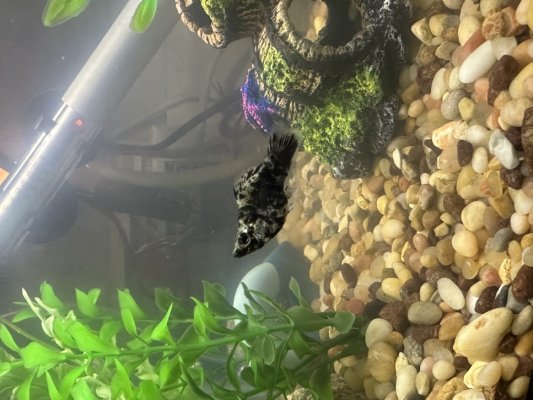Jguglielmo
Aquarium Advice Newbie
Hi guys! I’m new to this hobby and having some issues and hoping someone can give me some advice…
So I have a 10 gallon freshwater tank with 3 Mollies, 1 Platy and 1 Molly fry (in her own net) from one of my adult Mollies. I cycled the tank prior to getting them and got them all about 3 weeks ago. Everything was going well- 0 ammonia/nitrate levels, PH of ~7.6 and temp at about 80 degrees F. Using a carbon filter. Last week I noticed one Molly kind of gasping at the surface so I went out and bought an air stone to attempt to rectify the issue, thinking it was due to aeration. It seemed to help a bit but the more I read online, the more it seemed like it could be Velvet. Its scales are a copper-ish color and it seems a little lethargic but still willing to eat and swim around, just seems to tire easily sometimes. Within the next day or so my other fish were getting some of that color to them, too. I went and got Ich-x and the people at the aquarium store said that since it seemed to have spread, just treat your whole tank once a day then do a daily water change(conditioning new water), prior to the next treatment (filter running but carbon cartridge removed.) I have been doing this for 2 days, today being the third. The tank is pretty cloudy and my ammonia/nitrate levels are up to .25%. I added some Fritz&zyme7 and ammo lock to help but I’m nervous to continue treating with Ich-x. The fish are all acting fine and normal but I understand that Velvet can wipe out your tank within days.
Any advice would be appreciated! Thanks
So I have a 10 gallon freshwater tank with 3 Mollies, 1 Platy and 1 Molly fry (in her own net) from one of my adult Mollies. I cycled the tank prior to getting them and got them all about 3 weeks ago. Everything was going well- 0 ammonia/nitrate levels, PH of ~7.6 and temp at about 80 degrees F. Using a carbon filter. Last week I noticed one Molly kind of gasping at the surface so I went out and bought an air stone to attempt to rectify the issue, thinking it was due to aeration. It seemed to help a bit but the more I read online, the more it seemed like it could be Velvet. Its scales are a copper-ish color and it seems a little lethargic but still willing to eat and swim around, just seems to tire easily sometimes. Within the next day or so my other fish were getting some of that color to them, too. I went and got Ich-x and the people at the aquarium store said that since it seemed to have spread, just treat your whole tank once a day then do a daily water change(conditioning new water), prior to the next treatment (filter running but carbon cartridge removed.) I have been doing this for 2 days, today being the third. The tank is pretty cloudy and my ammonia/nitrate levels are up to .25%. I added some Fritz&zyme7 and ammo lock to help but I’m nervous to continue treating with Ich-x. The fish are all acting fine and normal but I understand that Velvet can wipe out your tank within days.
Any advice would be appreciated! Thanks


 This is a lot for a beginner to handle at once! I feel bad seeing them suffering
This is a lot for a beginner to handle at once! I feel bad seeing them suffering